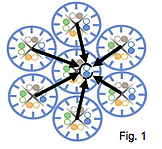So, contractor or design specialist- you have decided that a Category 6A infrastructure will support you network needs. You realize that 10 gigabit Ethernet is your application of choice; of course, you realize that at the rate that throughput demand is growing, not preparing for 10 gigabit Ethernet will significantly hinder future network upgrades. But now, another decision is waiting to be made... Should you choose an unshielded Category 6A solution or a shielded one? What are the main advantages and disadvantages of each? Hitachi Cable America's white paper will identify the strengths and weaknesses of each solution to help you determine the appropriate choice for your network.
See an excerpt from the white paper below, or click here to view the full paper.
Category 6A is the latest infrastructure performance level to be widely accepted. Accommodating network speeds that are 10 times that of the previous application (1 gigabit Ethernet), 10 gigabit Ethernet over a Category 6A infrastructure offers the throughput that many users now demand. This increase in the data burden of that application, however, requires a higher level of performance from the infrastructure than previous solutions were capable of providing.
 Category 6A cable, in accordance to the TIA/EIA 568-C.2 standard, is tested from 1 to 500MHz. This wide range of frequency is required to handle the frequencies at with 10GBase-T (10 gigabit Ethernet) operates. As a result of the higher frequencies utilized by 10GBase-T, alien crosstalk performance parameters are incorporated into the TIA/EIA standard for Category 6A cable and connectivity. Alien crosstalk occurs when signal from a cable jumps to an adjacent cable. Alien crosstalk, like crosstalk that occurs between the pairs within a cable, will have a detrimental impact on cable’s ability to send and receive data packets. Category 6A is the first cable category standard to include alien crosstalk performance parameters. Figure 1 shows the required alien crosstalk test configuration (known as “six around one”) for verification of Category 6A performance. The inner cable, called the victim, is evaluated while the outer cables are energized.
Category 6A cable, in accordance to the TIA/EIA 568-C.2 standard, is tested from 1 to 500MHz. This wide range of frequency is required to handle the frequencies at with 10GBase-T (10 gigabit Ethernet) operates. As a result of the higher frequencies utilized by 10GBase-T, alien crosstalk performance parameters are incorporated into the TIA/EIA standard for Category 6A cable and connectivity. Alien crosstalk occurs when signal from a cable jumps to an adjacent cable. Alien crosstalk, like crosstalk that occurs between the pairs within a cable, will have a detrimental impact on cable’s ability to send and receive data packets. Category 6A is the first cable category standard to include alien crosstalk performance parameters. Figure 1 shows the required alien crosstalk test configuration (known as “six around one”) for verification of Category 6A performance. The inner cable, called the victim, is evaluated while the outer cables are energized.
Click here for more Hitachi Cable America cabling solutions.


.png?width=58&height=58&name=X_logo_2023_(white).png)
